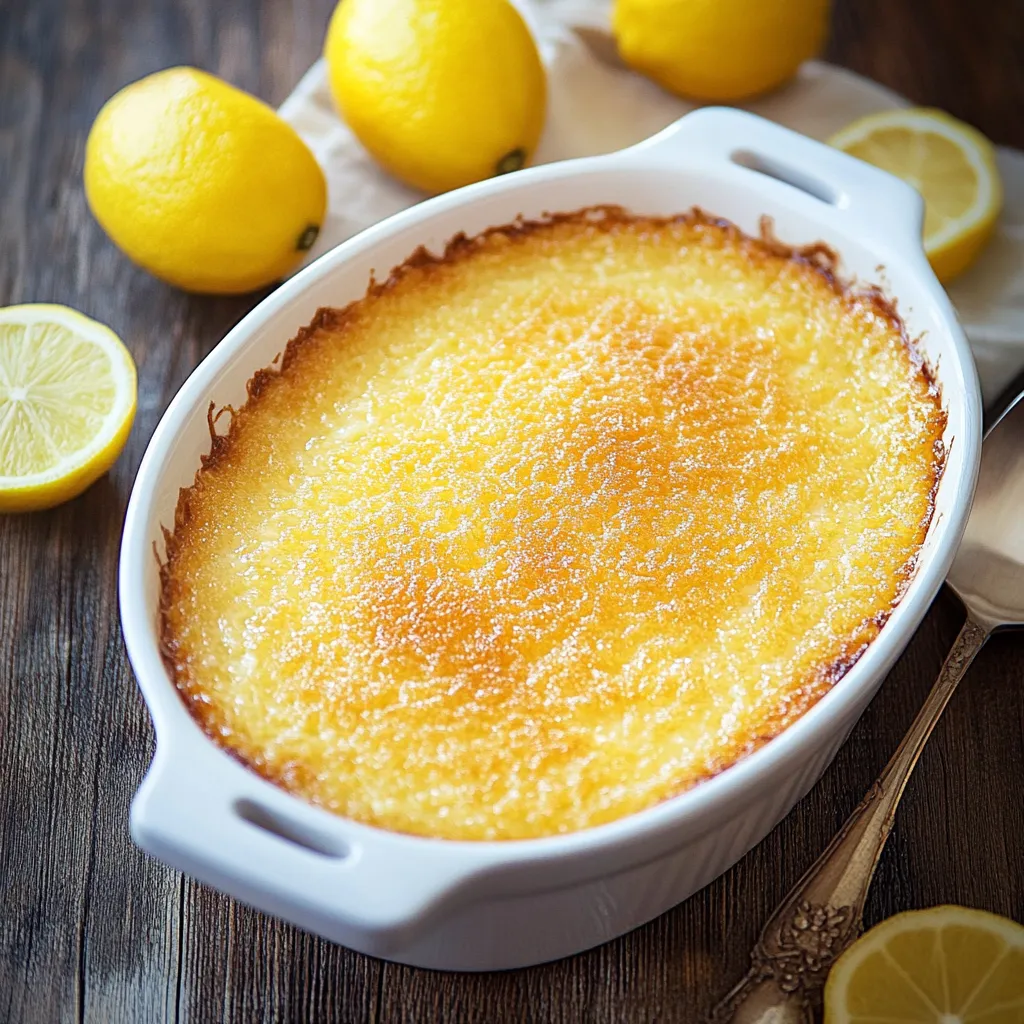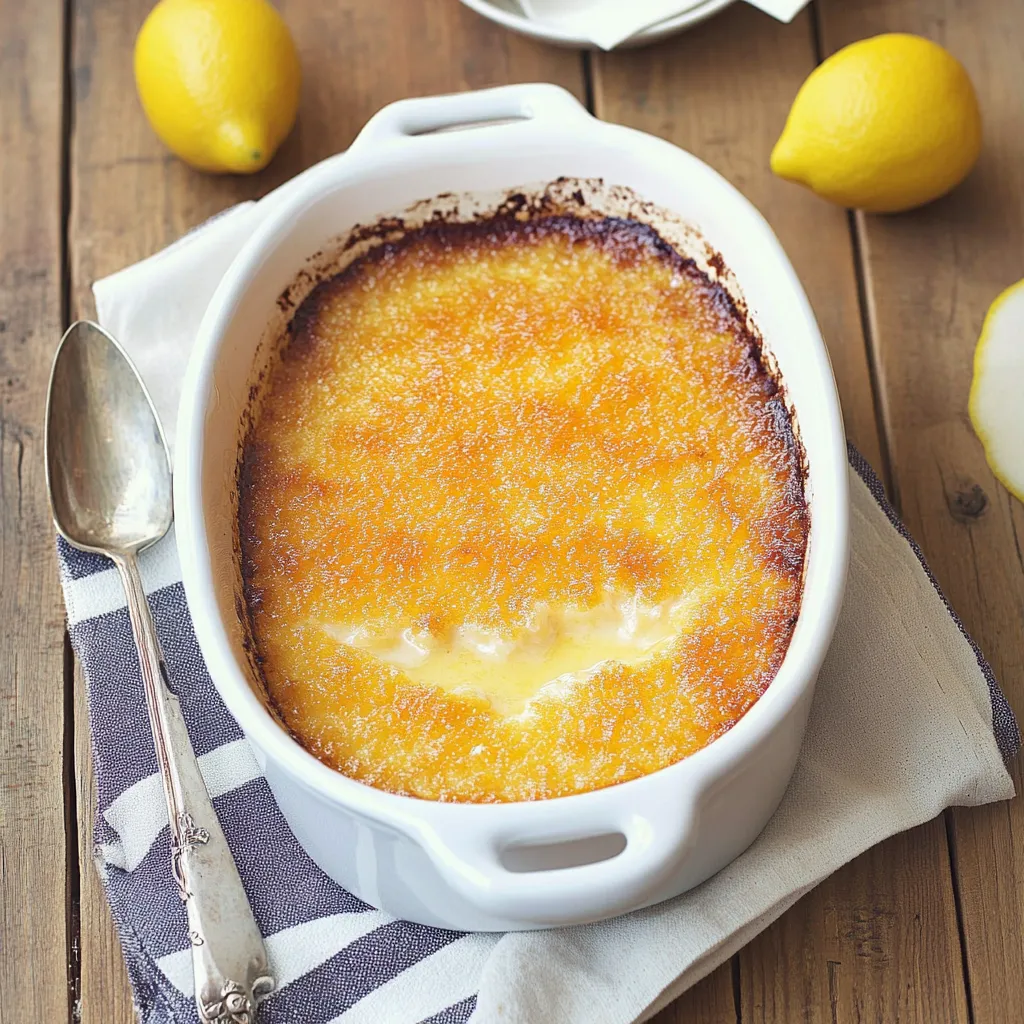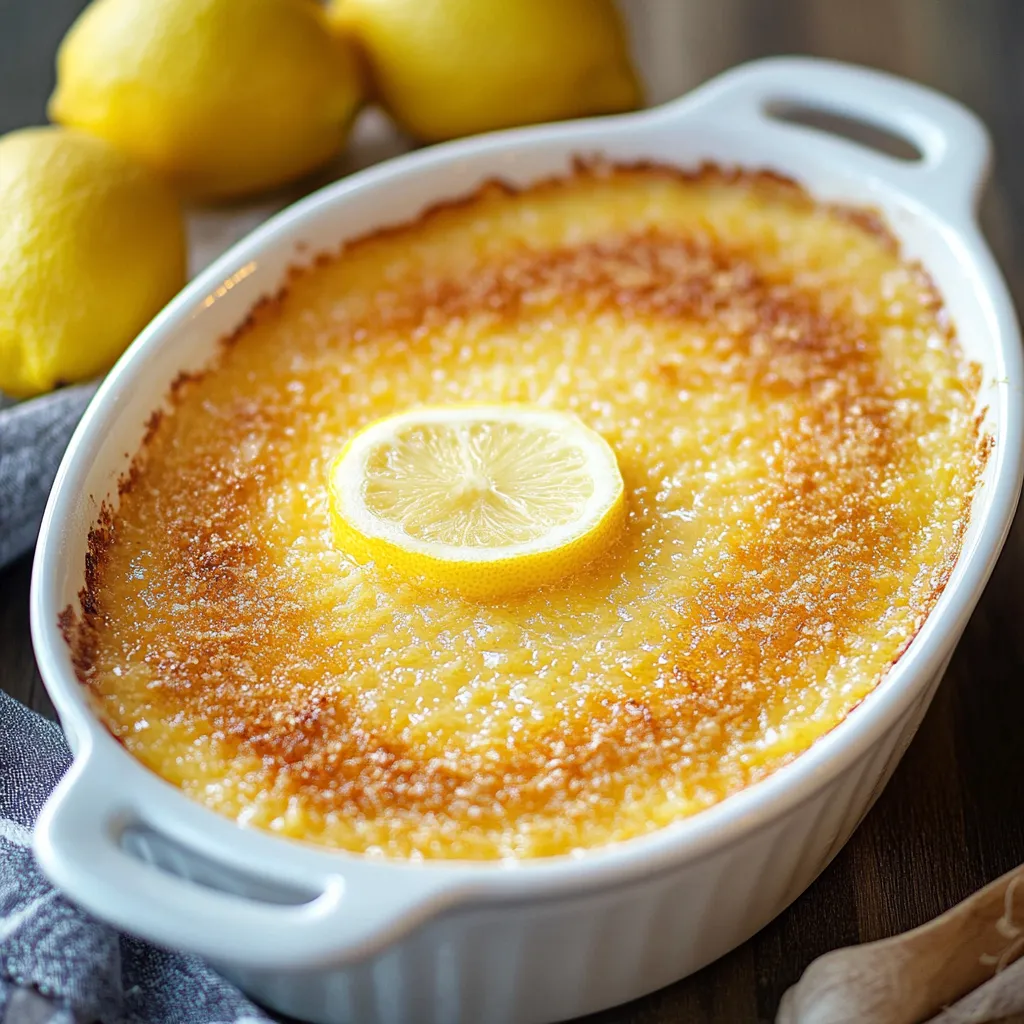 Pin it
Pin it
This self-saucing lemon pudding transforms simple ingredients into a magical dessert that separates into a light sponge cake layer on top and a warm, tangy lemon sauce underneath. The contrast between the fluffy cake and silky sauce creates a comforting dessert that's both impressive and surprisingly easy.
I discovered this Jamie Oliver recipe during a particularly dreary winter, and it quickly became my go-to comfort dessert. The bright lemon flavor and warming texture never fails to bring a bit of sunshine to even the gloomiest evening.
Ingredients
- Butter: Adds richness and helps create that tender crumb in the cake layer
- Sugar: Balances the tartness of lemon while helping create that golden top
- Fresh lemon zest and juice: Provides the essential bright flavor; use organic lemons if possible for the best flavor
- Eggs: Serve dual purposes; the yolks enrich the batter while the whites, when beaten separately, create the magical rising effect
- Self-raising flour: Contains the perfect amount of leavening agents to create that perfect fluffy top layer
- Milk: Creates the perfect consistency for the batter that allows the pudding to separate during baking
Step-by-Step Instructions
- Preheat the Oven:
- Set your oven to 200ºC/400ºF/gas 6 to ensure it's properly heated when your pudding goes in. This higher temperature helps create that beautiful contrast between the cake top and sauce bottom.
- Prepare the Butter Mixture:
- Place the butter and sugar in a large mixing bowl and grate the lemon zest directly over it. Cream together using an electric mixer or wooden spoon until the mixture becomes noticeably lighter in color and fluffy in texture. This process incorporates air into the batter which is crucial for the light texture of the top layer.
- Incorporate Egg Yolks and Flour:
- Carefully separate your eggs, placing whites in a clean bowl for later use. Add the yolks one at a time to your butter mixture, beating well after each addition. Gradually add the flour in small batches, beating continuously to prevent any lumps from forming. This methodical approach ensures a smooth batter.
- Add Liquid Elements:
- Pour in the milk and freshly squeezed lemon juice, stirring gently to combine. The mixture will look quite loose at this stage, which is exactly what you want. This liquid provides the foundation for the magical sauce that will form at the bottom.
- Whip and Fold Egg Whites:
- Using clean beaters, whisk the egg whites until they form stiff peaks when you lift the beaters. They should be glossy and hold their shape. Using a large metal spoon, carefully fold the whites into the batter with a gentle cutting and folding motion. Maintain as much air as possible in the mixture as this creates the light sponge top.
- Prepare Baking Setup:
- Generously butter a 1.5-liter ovenproof dish, ensuring all sides are coated. Pour the batter into the dish; it will be quite liquid. Place this dish inside a larger roasting tin and carefully pour hot water into the larger tin until it reaches about one third up the sides of your pudding dish. This water bath ensures gentle, even cooking.
- Bake to Perfection:
- Place in the preheated oven and bake for approximately 45 minutes. The pudding is ready when the top has risen, becomes golden brown, and feels springy to the touch. The magic happens during baking as the mixture separates into distinct layers.
 Pin it
Pin it
My absolute favorite part of this dessert is watching guests' faces when they spoon into what appears to be a simple lemon cake, only to discover the hidden sauce beneath. My daughter now requests this pudding for every special occasion, declaring it tastes like sunshine in a bowl.
Make Ahead and Storage
This pudding is best enjoyed warm from the oven when the contrast between the fluffy top and silky sauce is most pronounced. However, you can prepare it up to a day ahead and store it covered in the refrigerator. To reheat, place in a 150°C/300°F oven for about 15 minutes until warmed through. The texture will change slightly, but the flavor remains delicious.
Perfect Pairings
While this pudding is wonderful on its own, it reaches new heights when served with the right accompaniments. A dollop of cold heavy cream creates a beautiful temperature contrast with the warm pudding. Vanilla ice cream melts slightly into the warm sauce, creating an incredible texture. For a lighter option, try serving with a spoonful of Greek yogurt, which adds a pleasant tangy note.
Troubleshooting Tips
If your pudding doesn't separate properly into distinct layers, there are a few likely culprits. Overbeating the egg whites or being too rough when folding them in can deflate the mixture. The oven temperature being too low can also prevent proper separation. Always ensure your oven is fully preheated, and use an oven thermometer if possible to verify the temperature.
 Pin it
Pin it
A warm, comforting dessert that feels like a hug in every bite — a perfect end to any meal.
Frequently Asked Questions
- → What makes this lemon pudding 'self-saucing'?
During baking, the mixture separates into two distinct layers - a light sponge cake on top and a warm lemon sauce underneath. This separation happens naturally from the ingredients and baking method, creating its own sauce without additional steps.
- → Why do I need to bake this pudding in a water bath?
The water bath (bain-marie) provides gentle, even heat that helps the pudding cook properly and develop its two distinct layers. It prevents the bottom from cooking too quickly, allowing the sauce to form properly while the top becomes spongy.
- → Can I make this pudding ahead of time?
While best served warm from the oven, you can make it a few hours ahead. Reheat gently in a low oven (about 160°C/320°F) for 10-15 minutes before serving to restore the warm, comforting texture.
- → What can I serve with Jamie's lemon pudding?
This dessert pairs beautifully with a dollop of cold double cream or a scoop of vanilla ice cream. The temperature contrast enhances the experience. For a lighter option, try fresh berries or a dusting of powdered sugar.
- → Can I use bottled lemon juice instead of fresh?
Fresh lemon juice is strongly recommended for the best flavor. This dessert relies on the bright, zesty quality of fresh lemons for both juice and zest. Bottled juice lacks the aromatic oils and vibrant flavor that make this pudding special.
- → How do I know when the pudding is perfectly baked?
The pudding is done when the top is set, springy to the touch, and golden brown. The center should still have a slight wobble when gently shaken - this indicates the sauce layer underneath is properly formed but not overcooked.
